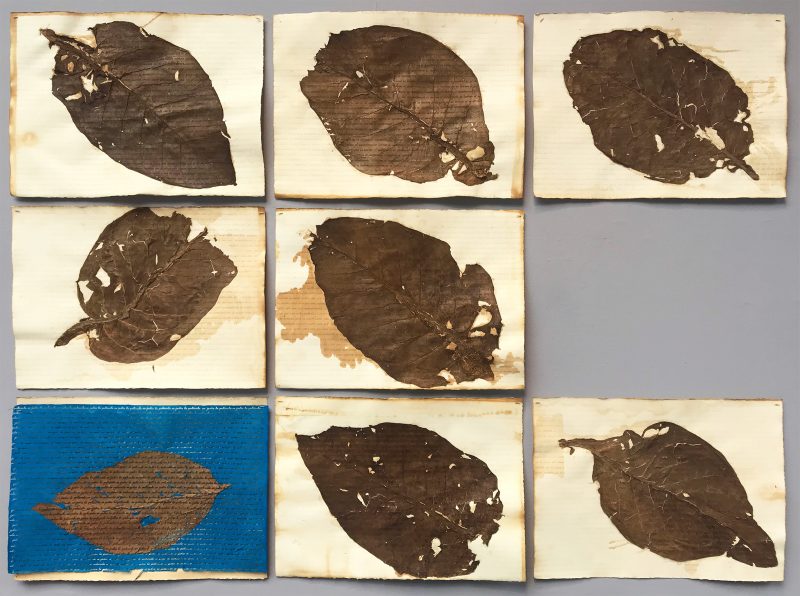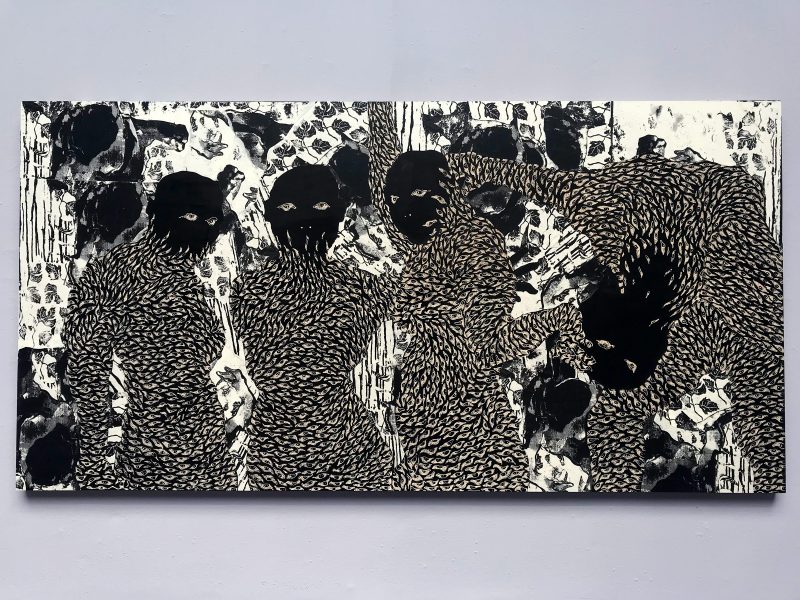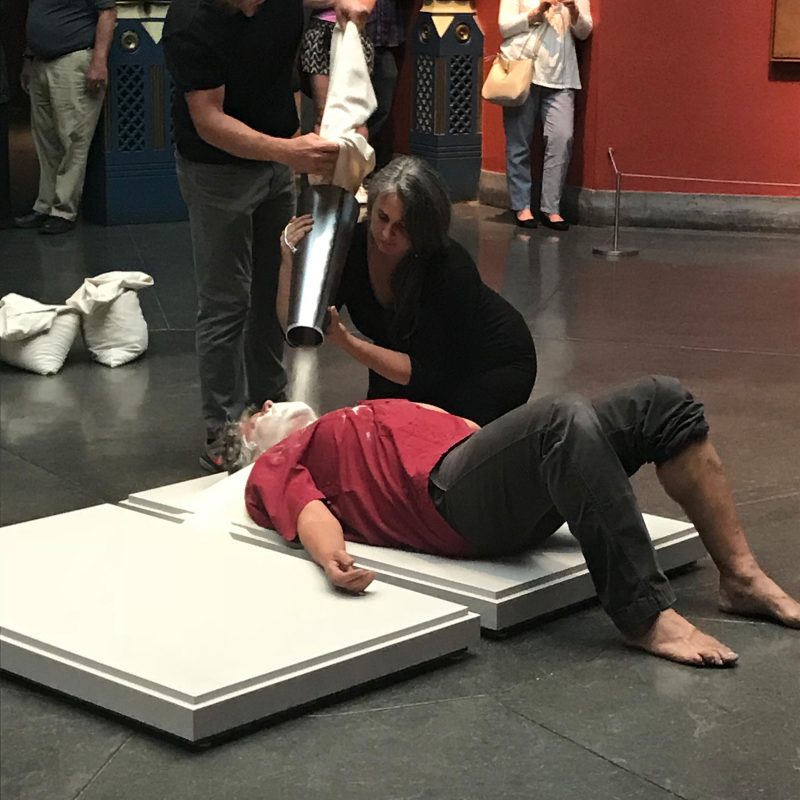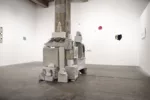In 2015, at the height of the European refugee crisis, Britain’s then-Prime Minister David Cameron was widely criticized for warning of a “swarm of people coming across the Mediterranean.” Donald Trump prefers to describe asylum-seekers and migrants in terms of “floods” and “flows” (or, occasionally, as “animals”), but the insidious effect of the rhetoric is the same. By metaphorically linking the refugee with plague and pestilence, such language strips its referents of human qualities, de-individuates, and incites xenophobic fear, historically a dangerously useful tool for right-wing politicians.
Evoking Diaspora
SWARM. is a powerful and mercifully timely counterstroke to fear of the other, the inundator, the unfathomable mass. An exhibition of painting, printmaking, collage, sculpture, installation, performance, and free combinations of these forms by the Haitian-born Didier William and Cuban-American Nestor Armando Gil, SWARM. confronts legacies of colonialism and diaspora by way of the artists’ particular, personal experiences. While William operates in two dimensions and Gil more often in three, both seek to break up the monolith of “immigrant culture” in the American imagination with work that mixes media and layers registers of associative significance.
Gil favors medium-scale sculptures made from provocative materials—rubber from inner tubes factors prominently in many of his SWARM. pieces, evoking the tenacity, ingenuity, and sheer desperation of the many Cubans who have converted the floatation devices into makeshift modes of transportation, fleeing their island for a better life in the United States. He also incorporates dried tobacco leaves into some of his works on paper, etching old sayings of his parents onto their brittle forms. A key colonial export product and continually fetishized mass commodity even and especially during the nominal US embargo on Cuban cigars, the leaves of Gil’s pieces are inscribed with the traces of the generations of Cubans displaced or otherwise subjugated by the tobacco trade. They become striated with individuality, continuity, humor, and melancholy, bearing idiosyncratic epigrams of hard-won wisdom.

Every Eye is an I
William also strikes a balance between the elegiac and the celebratory in regarding his people’s complex past. His subjects tend to be figurative, running the gamut from close family members to heroes of the Haitian Revolution, the only successful of revolution lead by enslaved people in human history. William depicts them by carving, pasting, painting, and drawing on wood panels, and the best of these roiling surfaces are at once seductive, menacing, exultant, defiant, and flat-out gorgeous. The interplay between vibrant color and elemental black complements the crude delicacy of his signature motif; hundreds of eyes drilled directly into the panels have an uncanny ability to recede into the background as pure texture one moment and start awake into sentient confrontation the next.

Curators Laurel McLaughlin and Mechella Yezernitskaya offer an activated, if odd, alternative definition of their exhibition’s title word. “To ‘swarm,’” apparently, “is to teem, to converge, to confront en masse, period.” This is a fine formal description of William’s multitudes of eyes. They teem, they mass, even as they demand to be acknowledged as singular subjects; each eye is an I. However, this limited (and limiting) explanation has the bizarre effect of de-historicizing the work of two artists so obviously, even consumingly, interested in history; the ways in which the word “swarm” is very much alive in political discourse today go unmentioned. The curators further assert that the artists’ work “beckons viewers, as an imperative, to physically and intellectually ‘swarm’ conceptions of colonialism in order to disarm such narratives of power.” But who converges? Where? And to what purpose? What might it mean for an individual viewer to “physically” swarm “conceptions” of colonialism? These sentences are not well-served by close reading, and a call to action drained of all but affect is merely a fashionable posture.
Sugar, Tobacco, Coffee, Sand
The opening reception for SWARM. featured wine, cheese, and a choking sob of a performance by Gil. After a speech thanking PAFA’s donors was given, the artist began singing powerfully in Spanish, emerged from the crowd of the mingling well-heeled, removed his shirt and changed into one that once belonged to his father. He lay on his back on the gallery floor and attendants poured bags containing sugar, tobacco, coffee, and sand through a funnel into his mouth, pausing when he could no longer breathe and began to gasp. When this ritual reenactment of his people’s colonial trauma was complete, Gil rose, changed back into his street clothes, and resumed singing as he shuffled out of the gallery, voice breaking now with tears and from the strain of repeated near-suffocation. Even before he had finished this disturbing and achingly mournful song, attendants rushed in to sweep up the residue of the performance, presumably so no one’s stilettos would slip in the sugar. Then everyone had more wine and cheese. The smoldering presence of the artist was a great, mortifying offering; the stage-management of the event reduced it to endurance-art-as-party-trick.

But the occasionally tactless framing of Gil and William’s work cannot detract from its vitality, its beauty, and magnitude. Opening just two days after the Supreme Court handed down its decision to uphold Trump’s travel ban, while thousands of children are still being held in detention centers at our border with Mexico after being forcibly separated from their parents, SWARM. arrives at a moment when the US is more divided over the issue of immigration than at any point in most of its citizens’ lifetimes. It has never been more important for Americans to confront and be confronted by the eyes (and the “I”s) of those others our leaders are intent on representing as a terrifying, homogenous swarm.
SWARM. is on view at Pennsylvania Academy of the Fine Arts from June 30 – September 9, 2018









